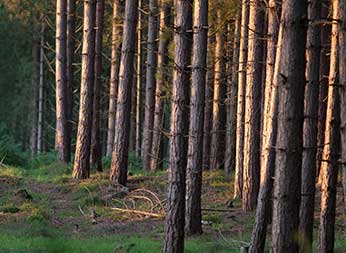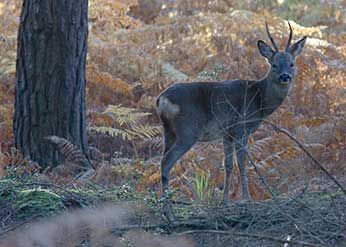Coniferous inclosures

Denny Inclosure
What best can be said in support of the landscape and wildlife value of New Forest conifers and coniferous woodland? ‘Not a lot’ would probably be most peoples’ response.
But that’s not quite the case, for New Forest conifers and coniferous woodland provide much of interest, particularly when the trees have been planted in relatively small blocks, are not too close together and feature species diversity, for New Forest conifers occur in such potentially baffling variety that identification alone can be something of a challenge - look out for the native Scots pine, and for Corsican pine, Weymouth pine, Douglas fir and Sitka spruce, as well as many ornamental varieties.
But what about the wildlife value?
Well, hidden deep amongst New Forest coniferous woodland, fox and deer like to lie-up during the day on comfortable beds of pine needles, appreciating the warmth and safety of these largely undisturbed places.
Grey squirrels, too, are often relatively abundant, and can be seen scampering about the woodland floor, or high above, acrobatically moving through the canopy. In late-spring and summer, they feast on a diet of small seeds obtained from deep within the cones. Look out for the evidence - large quantities of stripped cones litter the ground below the trees, and the remains of single cones are left on mossy stumps, the squirrel’s dining tables.
Tawny owls, too, and many other quieter, less noticeable birds, shelter from the worst of winter’s weather amongst the dense, evergreen foliage; whilst sparrowhawks favour the lower parts of the canopy in which to build their bulky nests. Conifers also provide nest sites for goshawks, hobbies, kestrels and buzzards.
And woodcocks use typically wide, coniferous woodland rides to guide their spring-time display flights, at dusk and dawn flapping along at tree-top height, mixing odd, intermittent frog-like croaks with softer ‘tsiwick’ calls of love.
Other birds are specially adapted for life amongst conifer foliage. Indeed, increases in the numbers of some have been attributed to the widespread use of conifers in forestry plantations.
Coal tits, for example, have relatively long toes and claws that enable acrobatic movement in the confined spaces of thickly needled branches, whilst exceptionally fine bills are a match for the tiny insects typically there present.
The robust, crossed mandibles of the aptly named crossbill are also designed for life amongst pine and spruce trees, enabling the birds to extract seeds from cones still on the trees. Small groups of these sturdy, colourful finches can sometimes be seen and heard as they acrobatically clamber high above, often using their bills for balance and support. Presence is betrayed by sound, explosive, repeated ‘chip-chip’ calls amongst a range of other twittering notes.

Even clear-felled areas of New Forest conifers are quickly colonised, once, of course, the dust has settled. Roe deer are usually amongst the first to move in, attracted by the food potential of re-generating or newly planted growth. A range of common birds will not be far behind, relatively scarce tree pipits may follow and in mid-May, nightjars may settle to breed. Newly arrived from African wintering sites, nightjars nest on the ground, and find these newly bare areas to their liking, at dusk and dawn filling the air with their distinctive, ‘churring’ sounds.
Notice also in coniferous woodland, enormous, conical southern wood ant nest mounds, home to colonies of ants sometimes tens of thousands strong. Usually placed on the edge of a clearing or beside a woodland ride that offers the prospect of warming sunshine, these bulky structures attract green woodpeckers with the promise of repeated feasting - listen for the woodpeckers' unmistakable, loud, laughing cries ringing through the trees.
Yes, visit New Forest coniferous woodland with an open mind, and you might find it to be surprisingly enjoyable.
(Add yet more interest to woodland walks - information about the fascinating history of these marvellous places is here: New Forest Inclosures).
References:
The New Forest – A Natural History: Colin R. Tubbs
The Birds of the Western Palearctic, Concise Edition: D.W. Snow and C.M. Perrins
More links
Other related links
Search this site

Sadly, 58 animals were killed - 35 ponies, 13 cows, 8 donkeys and 2 sheep, whilst a further 32 were injured - 3 pigs, 9 donkeys, 11 cows and 9 ponies.
(Forty-three accidents occurred in daylight, 15 at twilight and 101 in the dark. Twenty-seven accidents were not reported by the driver involved).
Here's just one horrific example - Three donkeys killed in collision with van at notorious New Forest blackspot (Advertiser and Times)
Sika deer continue to engage in rutting behaviour, and will do so until December.
Pigs seek out the remains of the acorn crop.
Beech leaves are transformed into a magnificent mosaic of glorious reds and golds. Other deciduous trees, too, take on an autumnal cloak before their leaves fall.
Dragonflies can occasionally be seen on the wing on bright days early in the month.
December
Foxglove leaves survive the winter at ground level, and offer the prospect of colourful summer blooms to come.
Redwings and fieldfares, autumn and winter visitors, gorge on haws and holly berries.
Great grey shrikes and hen harriers hunt over the heaths and other open spaces.
Honeysuckle by the end of the month often shows welcome signs of new growth.

